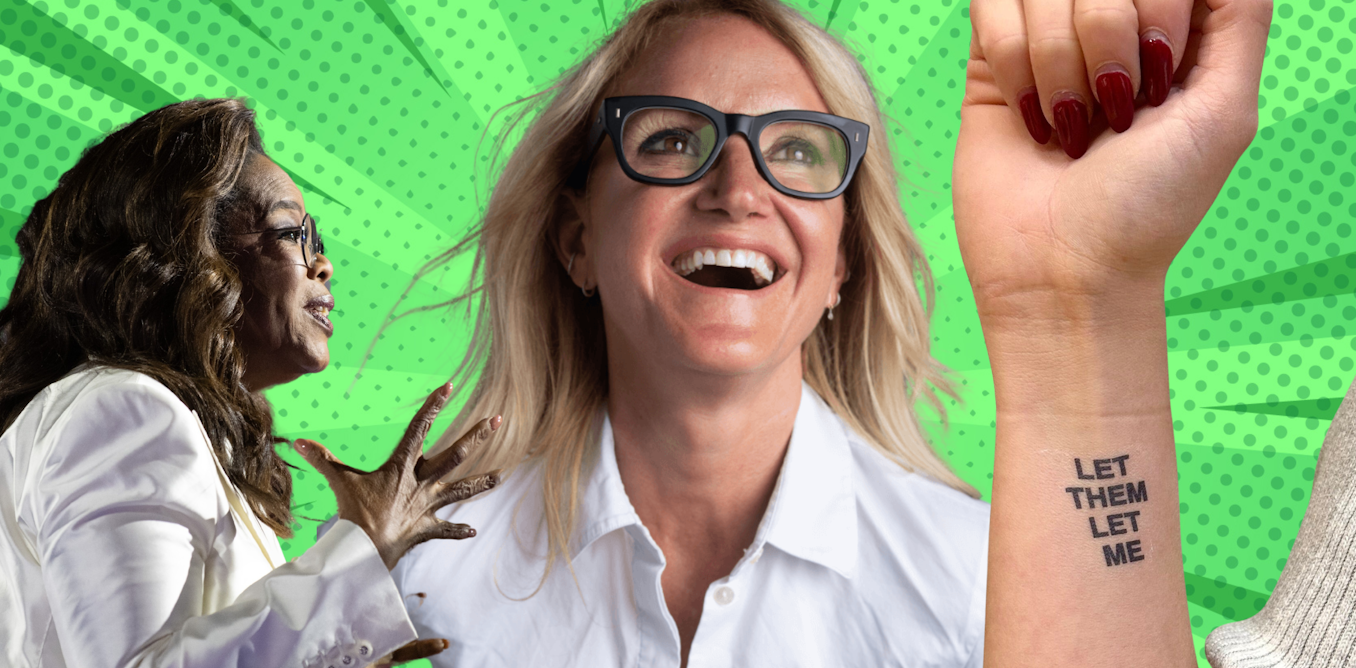So you want to write a self-help book? Let me help you.
First, you’ll need a catchy idea. Ideally it will name the key elements of something important. But keep it simple: “The 57 Habits of Highly Effective People” or “98 Steps to Infinite Happiness” aren’t going to cut it.
Your idea doesn’t have to be new. How many genuinely original ideas about human nature are there after thousands of years of self-reflection? Recycle old ideas but dress them in contemporary clothing.
Resist the temptation to be modest. In the crowded marketplace of self-improvement, you mustn’t hide your light under a bushel. Your readers know the norms of the genre and will tolerate levels of preening and hyperbole they wouldn’t accept anywhere else.
Speaking of that marketplace, don’t pretend there are no other self-help authors. Find ways to acknowledge and applaud popular ones and align their ideas with yours. It might be the beginning of a beautiful cross-promotional friendship.
Goodreads
Add a dash of science, but don’t overdo it. Like salt, too much will make the stew unappetising. The science is usually complex and unsettled, so doing justice to it will only muddy your message.
Where possible, upgrade the research you cite from psychology to neuroscience. Instead of “fear”, “self-control” and “pleasure”, say “amygdala”, “prefrontal cortex” and “dopamine”. People don’t have strong intuitions about brains, so they’ll be more impressed and credulous when you write about them.
If your recipe for personal growth has a specific focus – becoming a better partner or parent, losing weight, overcoming addiction or trauma, getting ahead at work – so be it. But see if you can widen its focus so it speaks to other topics.
Don’t underestimate the importance of your persona. You need to come across as capable but relatable. Use lots of personal anecdotes, both to illustrate your formula for success and to humanise yourself.
Show readers you share their everyday struggles and failings. They need to like you, not see you as an unreachable, envy-making icon.
The Let Them Theory
Anyone wishing to see this formula applied to perfection should look no further than Mel Robbins, author of the virally successful new book The Let Them Theory.
The Guardian reported a trend for Let Them tattoos. The hashtag #letthem has over 206,000 posts on TikTok. On her podcast, Oprah called the book both “a game-changer” and “a life-changer”. And within a month of its release date, it had sold over 1.2 million copies.
Robbins’ previous books, The 5 Second Rule (not about dropped food) and The High 5 Habit, were bestsellers, and she has built a vast online presence, including a podcast currently topping the iTunes chart.
Whereas her earlier works were intended to help people overcome inertia and under-confidence, Let Them moves into the troubled waters of relationships. Rather than make us better stewards of our personal motivation and self-esteem, it aspires to help us deal with the endless frustrations, impositions and disappointments of other people.
Robbins abandons her previous fondness for five-item formulas and gives us the mantra-like “Let them”. In essence, we should recognise we can’t control what other people think and do, and should therefore stop being bothered by it.
She shared a couple of examples on the NBC Today show recently: “The person you’re dating doesn’t want a commitment. Let them. Your company is laying people off. Let them.”
We spend too much time and energy accommodating others, trying to change them and worrying what they think of us. We can only control ourselves, so we should focus on choosing the life we want. This she calls Let Me, the inseparable but unsung companion to Let Them.
Robbins frames Let Me as a way to reclaim power. By allowing others to dictate how we act, think and feel, we give them the power to affect us. Saying Let Them takes back that power and allows us to wield it for our own benefit, she writes.
The book is saturated with the language of control and power. Lacking them is what troubles and motivates people, Robbins suggests.
The need for control is repeatedly described as a “hard-wired” feature of human nature. Described in a zero-sum manner – the more you have, the less I do – it is front and centre in Let Them’s account of what makes relationships challenging.
It’s important to clarify what Let Them doesn’t mean. To Robbins, it doesn’t mean we should passively accept everything in life. It doesn’t mean we should let people do bad things to us (“They want to poke me in the eye with a sharp stick? Let them!”).
Let Them also doesn’t mean we should be selfish. Many of Robbins’ examples look like enlightened selfishness, but she argues Let Them improves relationships by clarifying boundaries, reducing conflict and allowing loved ones to make positive changes by no longer enabling them.
In theory, Let Them means accepting and emotionally detaching from challenging aspects of other people, not disconnecting from them.
Despite these clarifications of what it is and isn’t, what Let Them entails remains somewhat ambiguous throughout the book. Whatever Robbins’ intentions, a reader might easily read it as a call to look out for number one, to cut difficult people loose and to see relationships as power struggles.
However beneficial its advice might be, Let Them asks us to insulate ourselves psychologically from other people. At its heart, it is a deeply individualistic prescription that draws a sharp line between the self and others.

Ron Lach/AAP
Research evidence
The basic idea of Let Them can be distilled into three propositions. First, how we should respond to something depends on whether we can control it. Second, because we can’t control other people, the best way to cope with the challenges they pose is detached acceptance. Third, because we can control ourselves, we should seize responsibility and actively choose our own path, guided by our values.
Psychological research shines a light on each of these propositions. Whether the best way to cope with an event depends on its controllability has been a focus of research on coping strategies since the 1980s. The idea itself is much older, dating at least to the Stoics, and is spelled out in the famous Serenity Prayer:
God, grant me the serenity to accept the things I cannot change, the courage to change the things I can, and the wisdom to know the difference.
Studies find forms of emotion-focused coping, which modify how we respond to an event rather than the event itself (including acceptance and distancing), are usually more effective when stressful events are outside our control. In general, though, problem-focused coping strategies, such as actively confronting the stressor, tend to be more effective, especially when it is to some degree controllable.
Studies generally find that flexible use of coping strategies is most effective, so Robbins’ advice to adjust our responses to the controllability of the problem is well founded. But is the detached acceptance she advocates effective?
Research on emotion regulation suggests it often is. Meta-analyses find using acceptance strategies is associated with better emotional outcomes, such as the ability to tolerate distress.
This finding should come as no surprise, because acceptance is a primary ingredient of the well-established Acceptance and Commitment Therapy approach to psychotherapy. It is also central to mindfulness interventions.
Even if acceptance strategies are effective and suited to uncontrollable problems, however, it doesn’t follow that we can’t control other people, as Robbins argues. They are not puppets on strings, of course, but they can be persuaded, instructed, cajoled, manipulated and role-modelled. In short, people can be controlled imperfectly, or influenced.
Robbins takes a black-or-white view of the uncontrollability of other people to justify letting them be. She then smuggles in the concept of influence when offering advice on how not to let them be: how to make friends and deal with slovenly spouses.
Just as others aren’t entirely outside our control, we aren’t entirely inside it. The Let Them world, where we control what’s ours and can’t control what’s theirs, is a polarised one far removed from the interconnected reality of social life.
Robbins’ third proposition is on more solid ground. She is unquestionably correct in promoting the value of an action-oriented, problem-focused or agentic approach to life. Countless studies point to the benefits of traits and mindsets that foster authenticity and autonomy. Even if the argument for Let Them can be questioned, Let Me is uncontroversial.

Michael Burrows/Pexels
Self-help books might help
It’s easy (and fun) for bookish types to be snooty about self-help titles like The Let Them Theory. They can be simplistic, naïve, immodest, one-note, grandiose, unnuanced, breathless, name-droppy, scientifically unsupported or just plain wrong.
They can make change look easy – just follow these fail-safe rules for happiness! – when we know it’s hard. They often overlook how much the difficulties we face are beyond our control, and as a result they imply we’re responsible when we don’t overcome them.
All of this criticism is fair, but it also misses the point. The main goal of the self-help book – aside from selling itself – is to instigate change rather than to capture complex truths. It aims to convey an idea or technique that will hook into readers’ minds and inspire positive action, not to offer a sober, scientifically sound account of psychological reality.
Different hooks will work with different people. Let Them will resonate with some readers and give them an easy-to-apply, all-purpose tool (“mind-hack”, to use the vernacular) for approaching life problems. It won’t resonate with others. Many readers of the self-help genre read multiple books in the hope of finding new and better ways to be hooked.
This is exactly what a good therapist would do. Some techniques won’t work with a particular client and some formulations of their problems won’t make sense to them, however well-founded they may be. Therapy aims to find the keys that fit the client’s mental locks.
A self-help book may only offer a single key, and it may be the wrong one for many people. But for roughly the price of five minutes of therapy – based on the Australian Psychological Society’s recommended hourly consultation rate – that’s not such a bad deal.
If we accept that the aim of a self-help book is to persuade and be actionable, its simplifications and overconfident claims are features, not bugs. Easily remembered, simple ideas are exactly the ones that have a chance of being implemented. They might even work.
People may mock pop psychology, scoff at the inflated claims of self-improvement gurus and sneer at self-help books. Let them.

The post “TikTok and Oprah love the ‘deeply individualistic’ self-help trend. Can it help you? We asked an expert” by Nick Haslam, Professor of Psychology, The University of Melbourne was published on 04/23/2025 by theconversation.com





































Leave a Reply